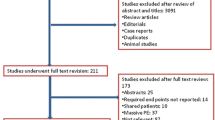Abstract
Acute pulmonary embolism (APE) is a common sudden venous thromboembolism with high rates of morbidity and mortality. Several studies have concluded that microRNA-134 could be a potential biomarker for APE. However, the sensitivity of these studies varies widely. This study aimed to evaluate the diagnostic value of circulating microRNA-134 levels for APE. Four databases were searched to retrieve articles focusing on microRNA-134 detection in APE diagnosis. The Quality Assessment of Diagnostic Accuracy Studies-2 was used to evaluate the quality of the included literature. This meta-analysis included seven studies and 383 subjects. The microRNA-134 levels in APE patients were higher than those in controls (SMD = 2.84, z = 3.69, p < 0.001). The pooled sensitivity, specificity, and diagnostic odds ratio were 0.86 (0.72–0.94), 0.75 (0.66–0.82), and 19 (7–51), respectively. The positive and negative likelihood ratios were 3.4 (2.4–4.8) and 0.18 (0.08–0.40), respectively. The area under the summary receiver operating characteristic curve was 0.81 (0.77–0.84). Circulating microRNA-134 may be a new biomarker for the diagnosis of APE, but more tests and studies are needed to further explore and prove this. Trial registration number: PROSPERO registration #CRD42020184072





Similar content being viewed by others
Abbreviations
- APE:
-
Acute pulmonary embolism
- NSTEMI:
-
Non-ST segment elevation myocardial infarction
- SROC:
-
Summary receiver operating characteristic
- AUC:
-
The area under the summary receiver operating characteristic curve
- SEN:
-
Sensitivity
- SPE:
-
Specificity
- PLR:
-
Positive likelihood ratio
- NLR:
-
Negative likelihood ratio
- DOR:
-
Diagnostic odds ratio
References
Konstantinides, S. V., Barco, S., Lankeit, M., & Meyer, G. (2016). Management of pulmonary embolism: an update. Journal of the American College of Cardiology, 67(8), 976–990. https://doi.org/10.1016/j.jacc.2015.11.061.
Giordano, N. J., Jansson, P. S., Young, M. N., Hagan, K. A., & Kabrhel, C. (2017). Epidemiology, pathophysiology, stratification, and natural history of pulmonary embolism. Techniques in Vascular and Interventional Radiology, 20(3), 135–140. https://doi.org/10.1053/j.tvir.2017.07.002.
Douma, R. A., Kamphuisen, P. W., & Buller, H. R. (2010). Acute pulmonary embolism. Part 1. Epidemiology and diagnosis. Nature Reviews. Cardiology, 7(10), 585–596. https://doi.org/10.1038/nrcardio.2010.106.
Doherty, S. (2017). Pulmonary embolism: an update. Australian Family Physician, 46(11), 816–820.
Righini, M., & Robert-Ebadi, H. (2018). Diagnosis of acute pulmonary embolism. Hamostaseologie, 38(1), 11–21. https://doi.org/10.5482/HAMO-17-07-0023.
Lin, Y. T., Tsai, I. C., Tsai, W. L., Lee, T., Chen, M. C., Lin, P. C., et al. (2010). Comprehensive evaluation of CT pulmonary angiography for patients suspected of having pulmonary embolism. The International Journal of Cardiovascular Imaging, 26(Suppl 1), 111–120. https://doi.org/10.1007/s10554-009-9573-8.
Stein, P. D., Woodard, P. K., Weg, J. G., Wakefield, T. W., Tapson, V. F., Sostman, H. D., et al. (2007). Diagnostic pathways in acute pulmonary embolism: recommendations of the PIOPED II investigators. Radiology, 242(1), 15–21. https://doi.org/10.1148/radiol.2421060971.
Meyer, G. (2014). Effective diagnosis and treatment of pulmonary embolism: improving patient outcomes. Archives of Cardiovascular Diseases, 107(6–7), 406–414. https://doi.org/10.1016/j.acvd.2014.05.006.
Crawford, F., Andras, A., Welch, K., Sheares, K., Keeling, D., & Chappell, F. M. (2016). D-dimer test for excluding the diagnosis of pulmonary embolism. Cochrane Database of Systematic Reviews, 8, CD010864. https://doi.org/10.1002/14651858.CD010864.pub2.
Konstantinides, S. V., Meyer, G., Becattini, C., Bueno, H., Geersing, G. J., Harjola, V. P., et al. (2019). 2019 ESC guidelines for the diagnosis and management of acute pulmonary embolism developed in collaboration with the European Respiratory Society (ERS): the Task Force for the diagnosis and management of acute pulmonary embolism of the European Society of Cardiology (ESC). The European Respiratory Journal, 54(3). https://doi.org/10.1183/13993003.01647-2019.
Bartel, D. P. (2004). MicroRNAs: genomics, biogenesis, mechanism, and function. Cell, 116(2), 281–297. https://doi.org/10.1016/s0092-8674(04)00045-5.
Kessler, T., Erdmann, J., Vilne, B., Bruse, P., Kurowski, V., Diemert, P., et al. (2016). Serum microRNA-1233 is a specific biomarker for diagnosing acute pulmonary embolism. Journal of Translational Medicine, 14(1), 120. https://doi.org/10.1186/s12967-016-0886-9.
Deng, H. Y., Li, G., Luo, J., Wang, Z. Q., Yang, X. Y., Lin, Y. D., et al. (2016). MicroRNAs are novel non-invasive diagnostic biomarkers for pulmonary embolism: a meta-analysis. Journal of Thoracic Disease, 8(12), 3580–3587. https://doi.org/10.21037/jtd.2016.12.98.
Xiang, Q., Zhang, H. X., Wang, Z., Liu, Z. Y., Xie, Q. F., Hu, K., et al. (2019). The predictive value of circulating microRNAs for venous thromboembolism diagnosis: a systematic review and diagnostic meta-analysis. Thrombosis Research, 181, 127–134. https://doi.org/10.1016/j.thromres.2019.07.024.
Xiao, J., Jing, Z. C., Ellinor, P. T., Liang, D., Zhang, H., Liu, Y., et al. (2011). MicroRNA-134 as a potential plasma biomarker for the diagnosis of acute pulmonary embolism. Journal of Translational Medicine, 9, 159. https://doi.org/10.1186/1479-5876-9-159.
Wang, Y., Zhao, Z., Zhang, Y., Jiang, X., & Duo, J. (2017). Plasma miRNA-134 is a diagnostic biomarker for acute pulmonary embolism in middle and high altitude areas. Biomedical Research-India, 28(12), 5494–5498.
Haizhen, M. (2018). The expressions of plasma microRNA-134 for the acute pulmonary embolism at high altitude area. Master: Qinghai University.
Heng, Z. (2016). The diagnostic value of microRNA-134 for the acute pulmonary embolism at middle altitude. Master: Qinghai University.
Bang, Z., Ruchang, C., & Xiaodan, Z. (2018). Detection of serum miRNAs markers and clinical value of miR-134 in patients with acute pulmonary embolism. Clinical Education of General Practice, 16(6), 617–620.
McInnes, M. D. F., Moher, D., Thombs, B. D., McGrath, T. A., Bossuyt, P. M., & the, P.-D. T. A. G., et al. (2018). Preferred Reporting Items for a Systematic Review and Meta-analysis of Diagnostic Test Accuracy Studies: the PRISMA-DTA statement. JAMA, 319(4), 388–396. https://doi.org/10.1001/jama.2017.19163.
Whiting, P. F., Rutjes, A. W., Westwood, M. E., Mallett, S., Deeks, J. J., Reitsma, J. B., et al. (2011). QUADAS-2: a revised tool for the quality assessment of diagnostic accuracy studies. Annals of Internal Medicine, 155(8), 529–536. https://doi.org/10.7326/0003-4819-155-8-201110180-00009.
Deville, W. L., Buntinx, F., Bouter, L. M., Montori, V. M., de Vet, H. C., van der Windt, D. A., et al. (2002). Conducting systematic reviews of diagnostic studies: didactic guidelines. BMC Medical Research Methodology, 2, 9. https://doi.org/10.1186/1471-2288-2-9.
Zhou, X., Wen, W., Shan, X., Qian, J., Li, H., Jiang, T., et al. (2016). MiR-28-3p as a potential plasma marker in diagnosis of pulmonary embolism. Thrombosis Research, 138, 91–95. https://doi.org/10.1016/j.thromres.2015.12.006.
Glas, A. S., Lijmer, J. G., Prins, M. H., Bonsel, G. J., & Bossuyt, P. M. (2003). The diagnostic odds ratio: a single indicator of test performance. Journal of Clinical Epidemiology, 56(11), 1129–1135. https://doi.org/10.1016/s0895-4356(03)00177-x.
Lee, J., Kim, K. W., Choi, S. H., Huh, J., & Park, S. H. (2015). Systematic review and meta-analysis of studies evaluating diagnostic test accuracy: a practical review for clinical. Researchers-Part II. Statistical. methods of meta-analysis. Korean Journal of Radiology, 16(6), 1188–1196. https://doi.org/10.3348/kjr.2015.16.6.1188.
Kim, J. Y., Kim, K. H., Cho, J. Y., Sim, D. S., Yoon, H. J., Yoon, N. S., et al. (2019). D-dimer/troponin ratio in the differential diagnosis of acute pulmonary embolism from non-ST elevation myocardial infarction. The Korean Journal of Internal Medicine, 34(6), 1263–1271. https://doi.org/10.3904/kjim.2018.153.
Anderson, J. L., & Morrow, D. A. (2017). Acute myocardial infarction. The New England Journal of Medicine, 376(21), 2053–2064. https://doi.org/10.1056/NEJMra1606915.
Weitz, J. I., Fredenburgh, J. C., & Eikelboom, J. W. (2017). A test in context: D-dimer. Journal of the American College of Cardiology, 70(19), 2411–2420. https://doi.org/10.1016/j.jacc.2017.09.024.
Froehling, D. A., Elkin, P. L., Swensen, S. J., Heit, J. A., Pankratz, V. S., & Ryu, J. H. (2004). Sensitivity and specificity of the semiquantitative latex agglutination D-dimer assay for the diagnosis of acute pulmonary embolism as defined by computed tomographic angiography. Mayo Clinic Proceedings, 79(2), 164–168. https://doi.org/10.4065/79.2.164.
Jain, S., Khera, R., Suneja, M., Gehlbach, B., & Kuperman, E. (2015). Role of D-dimer assays in the diagnostic evaluation of pulmonary embolism. The American Journal of the Medical Sciences, 350(6), 501–507. https://doi.org/10.1097/MAJ.0000000000000405.
Wang, Q., Ma, J., Jiang, Z., Wu, F., Ping, J., & Ming, L. (2018). Diagnostic value of circulating microRNA-27a/b in patients with acute pulmonary embolism. International Angiology, 37(1), 19–25. https://doi.org/10.23736/S0392-9590.17.03877-9.
Qian, W. (2018). Diagnostic value and mechanism of plasma microRNA-27a/ b in patients with acute pulmonary embolism. Zhengzhou University.
Acknowledgments
Thanks to Associate Professor Yu Xiaojin, Department of Epidemiology and Health Statistics, School of Public Health, Southeast University, for her help and guidance in data processing and analysis.
Funding
This study was funded by Key Research and Development Project of Hebei Province: Study on circulating biomarkers of acute pulmonary thromboembolism and its application value in risk stratification and prognosis evaluation (grant number 182777198).
Author information
Authors and Affiliations
Corresponding authors
Ethics declarations
Conflict of Interest
The authors declare that they have no conflict of interest.
Ethical Approval
This article does not contain any studies with human participants or animals performed by any of the authors.
Additional information
Associate Editor Craig M. Stolen oversaw the review of this article
Publisher’s Note
Springer Nature remains neutral with regard to jurisdictional claims in published maps and institutional affiliations.
Rights and permissions
About this article
Cite this article
Liu, Y., Xie, M., Gao, X. et al. Predictive Value of Circulating microRNA-134 Levels for Early Diagnosis of Acute Pulmonary Embolism: Meta-analysis. J. of Cardiovasc. Trans. Res. 14, 744–753 (2021). https://doi.org/10.1007/s12265-020-10087-4
Received:
Accepted:
Published:
Issue Date:
DOI: https://doi.org/10.1007/s12265-020-10087-4




